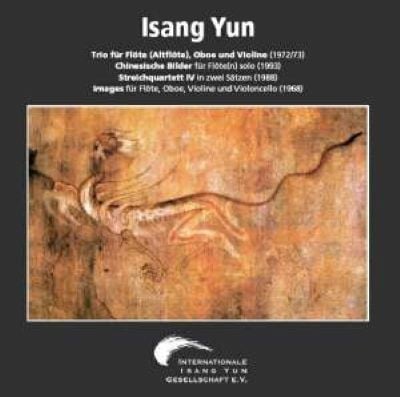Trio for flute, oboe and violin
(1972-73)fl(=afl).ob-vln
Abbreviations (PDF)
Bote & Bock
Yun's Trio for Flute (Alto Flute), Oboe and Violin (1972/73) has its origin in the Concertante Figures for small orchestra (1972). Following a restless beginning, Yun exposes in the orchestral work rather static, overlapping sheets of sound, which begin in a slow tempo and are then accelerated by degrees and brightened in colour. The various sheets of sound (characterised by steadily flowing internal movement) are established in all orchestral sections and are gradually extended and expanded in musical space. By means of a massive brass entry, Yun then organises a process of dramatisation. At the peripeteia of this process, which also marks the beginning of the last third of the composition, a trio comprised of alto flute (later: concert flute), oboe and violin is heard. In the orchestral piece the trio has a harmonising function: it develops the aspect of unity preceding a catastrophic tutti eruption, which is ultimately led back to a quieter atmosphere and fades away in the highest registers.
The trio of the orchestral composition (bars 249-283) was integrated without alteration into the Trio for Flute (Alto Flute), Oboe and Violin. However, Yun reversed the dramatic function of these 36 bars: in the new work, the music derived from the orchestral piece serves as a contrasting, concertante middle section (bars 47-82). For the new composition Yun added the introduction (bars 1-40), a transition (bars 41-46), and the ending (bars 83-143) in 1973.
The Trio (1972/73) begins with a long, intensely held c-sharp, the "main tone", which Yun splits up by means of heterophonic treatment and unfolds in a quiet development from a band of sound (bars 3-10: c2-c# 2-d2) to a sheet of sound (bars 35-40: f# 3-a3-e3). A contrasting transition leads into the depths. Chains of trills and large intervals in the alto flute open the middle part, in which Yun breaks through the static and ceremonial character of the first part by interspersing the long-drawn tones with broadly sweeping ornamental figures. Frequently guided upwards, these musical gestures are almost always directed towards certain central tones. In the third part Yun refers to the ceremonial beginning, picking up the pitches f3-f#3-g3. However, Yun modifies and magnifies the ceremonial character through intensified dynamics, the addition of little ornaments and, finally, even through the integration of concertante figurations, thus reconciling the difference between inertness and movement and thereby raising it to a higher level.
Walter-Wolfgang Sparrer

Roswitha Staege (flute), Burkhard Glaetzner (oboe), Uwe-Martin Haiberg (violin)
Internationale Isang Yun Gesellschaft IYG 001
